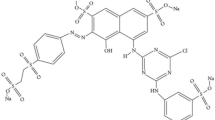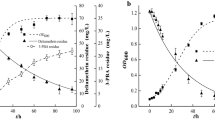Abstract
This study evaluated the capability of Serratia marcescens ABHI001 to effectively degrade p-cresol through different techniques. The molecular identity of the laboratory isolate S. marcescens ABHI001 was confirmed through the 16S ribosomal DNA gene pattern, and its morphological features were investigated through field-emission scanning electron microscopy. In addition, the degradation behavior of the isolate for cresol was verified using several techniques, including UV–visible spectroscopy, followed by high-performance liquid chromatography (HPLC), gas chromatography, and Fourier transform infrared spectroscopy. The maximum degradation percentage of 85% for p-cresol could be achieved after 18 h of incubation with S. marcescens ABHI001. The formation of p-hydroxybenzaldehyde, p-hydroxybenzoate, and protocatechuate metabolites was confirmed through HPLC. The study results indicate that S. marcescens ABHI001 may have applications in the bioremediation of organic pollutants, such as p-cresol.







Similar content being viewed by others
References
Agency for Toxic Substances and Disease Registry (ATSDR) (1990) Toxicological profile for cresols (Draft). US Public Health Service, US Department of Health & Human Services, Altanta
Agency for Toxic Substances and Disease Registry (ATSDR) (2008) Toxicological profile for cresols. U.S. Department of Health and Human Services, Public Health Service, Altanta
Al-Khalid T, El-Naas MH (2012) Aerobic biodegradation of phenols: a comprehensive review. Crit Rev Environ Sci Technol 42:1631–1690
Ansari AA, Gill SS, Gill R, Lanza GR, Newman L (2016) Phytoremediation: Management of environmental contaminants. Springer International Publishing AG, Switzerland
Balarak D, Mahdavi Y (2016) Survey of efficiency agricultural waste as adsorbent for removal of p-Cresol from aqueous solution. Int Res J Pure Appl Chem 10:1–11
Basheer F, Farooqi IH (2012) Biodegradation of p-cresol by aerobic granules in sequencing batch reactor. J Environ Sci 24:2012–2018. doi:10.1016/S1001-0742(11)60988-1
Berge-Lefranc D, Vagner C, Calaf R, Pizzala H, Denoyel R, Brunet P et al (2012) In vitro elimination of protein bound uremic toxin p-cresol by MFI-type zeolites. Microporous Mesoporous Mater 153:288–293
Bisht S, Pandey P, Bhargava B, Sharma S, Kumar V, Sharma KD (2015) Bioremediation of polyaromatic hydrocarbons (PAHs) using rhizosphere technology. Braz J Microbiol 46:7–21
Bossert ID, Whited G, Gibson DT, Young LY (1989) Anaerobic oxidation of p-cresol mediated by a partially purified methylhydroxylase from a denitrifying bacterium. J Bacteriol 171:2956–2962
Bouallegue O, Mzoughi R, Weill FX, Mahdhaoui N, Ben Salem Y, Sboui H, Grimont F, Grimont PA (2004) Outbreak of Pseudomonas putida bacteraemia in a neonatal intensive care unit. J Hosp Infect 57:88–91
Choquette-Labbé M, Shewa WA, Lalman JA, Shanmugam SR (2014) Photocatalytic degradation of phenol and phenol derivatives using a nano-TiO2 catalyst: integrating quantitative and qualitative factors using response surface methodology. Water 6:1785–1806. doi:10.3390/w6061785
Edalli VA, Mulla SI, Eqani SAMAS, Mahadevan GD, Sharma R, Shouche Y, Kamanavall CM (2016) Evaluation of p-cresol degradation with polyphenol oxidase (PPO) immobilized in various matrices. Biotech 6:1–8
Fang HHP, Zhou GM (2000) Degradation of phenol and p-cresol in reactors. Water Sci Technol 42:237–244
Huang WE, Hopper D, Goodacre R, Beckmann M, Singer A, Draper J (2006) Rapid characterization of microbial biodegradation pathways by FT-IR spectroscopy. J Microbiol Methods 67:273–280
Joutey NT, Bahafid W, Sayel H, El-Ghachtouli N (2013) Biodegradation: Involved microorganisms and genetically engineered microorganisms. Biodegradation-Life of Science, InTech Open, Croatia, pp 289–320
Khanam B, Chandra R (2015) Isolation and identification of endophytic bacteria producing bright red pigment from the dye yielding plant Beta vulgaris L. Int J Pharm Pharm Sci 7:220–224
Krastanov A, Alexieva Z, Yemendzhiev H (2013) Microbial degradation of phenol and phenolic derivatives. Eng Life Sci 13:76–87. doi:10.1002/elsc.201100227
Lim KT, Shukor MY, Wasoh H (2014) Physical, chemical, and biological methods for the removal of arsenic compounds. Biomed Res Int 2014:1–9
Lin J, Reddy M, Moorthi V, Qoma BE (2008) Bacterial removal of toxic phenols from an industrial effluent. Afr J Biotechnol 7:2232–2238
Liu Z, Xie W, Li D, Peng Y, Li Z, Liu S (2016) Biodegradation of phenol by bacteria strain Acinetobacter calcoaceticus PA isolated from phenolic wastewater. Int J Environ Res Public Health 13:300. doi:10.3390/ijerph13030300
Michałowicz J, Duda W (2007) Phenols–sources and toxicity. Polish J Environ Stud 16:347–362
Murthy A, Gayathri KV (2017) Halotolerant bacterial consortium able to degrade substituted phenolic compounds isolated from saline environment. Environ Risk Assess Remediat 1:22–29
Ren Y, Peng L, Zhao G, Wei C (2014) Degradation of m-cresol via the ortho cleavage pathway by Citrobacter farmeri SC01. Biochem Eng J 88:108–114
Reshma JK, Mathew A (2014) Biodegradation of phenol-aerobic and anaerobic pathways. Int J Sci Nat 5:366–387
Saxena M, Gupta S, Mahmooduzzafar Kumar R, Kumar A (2013) Identification and genetic characterization of phenol-degrading bacterium isolated from oil contaminated soil. Afr J Biotechnol 12:791–797
Singh RK, Kumara S, Kumara S, Kumar A (2008) Biodegradation kinetic studies for the removal of p-cresol from wastewater using Gliomastix indicus MTCC 3869. Biochem Eng J 40:293–303. doi:10.1016/j.bej.2007.12.015
Surkatti R, El-Naas M (2014) Biological treatment of wastewater contaminated with p-cresol using Pseudomonas putida immobilized in polyvinyl alcohol (PVA) gel. J Water Process Eng 1:84–90. doi:10.1016/j.jwpe.2014.03.008
Tamura K, Dudley J, Nei M, Kumar S (2007) MEGA4: molecular evolutionary genetics analysis (MEGA) software version 4.0. Mol Biol Evol 24:1596–1599
World Health Organization (1963) International Standards for Drinking Water. World Health Organization, Geneva
Xenofontos E, Tanase AM, Stoica I, Vyrides I (2016) Newly isolated alkalophilic Advenella species bioaugmented in activated sludge for high p-cresol removal. N Biotechnol 33:305–310. doi:10.1016/j.nbt.2015.11.003
Yao H, Ren Y, Wei C, Yue S (2011) Biodegradation characterisation and kinetics of m-cresol by Lysinibacillus cresolivorans. Water SA 37:15–20
Zarei M, Aminzadeh S, Zolgharnein H, Safahieh A, Ghoroghi A, Motallebi A, Daliri M, Lotfi AS (2010) Serratia marcescens B4A chitinase product optimization using Taguchi approach. Iran J Biotechnol 8:252–262
Zhang Z, Lo IMC, Yan DYS (2015) An integrated bioremediation process for petroleum hydrocarbons removal and odor mitigation from contaminated marine sediment. Water Res 83:21–30
Acknowledgements
The authors T.S., A.K.B., N.S., and P.K.M. acknowledge the Department of Chemical Engineering & Technology IIT (BHU), Varanasi, India, for conducting this study. The authors N.S. and P.K.M. acknowledge IIT (BHU), Varanasi, India, for providing the Institute Post-Doctoral Fellowship.
Author information
Authors and Affiliations
Corresponding author
Ethics declarations
Conflict of interest
The authors declare that they have no conflict of interest in the publication.
Rights and permissions
About this article
Cite this article
Singh, T., Srivastava, N., Bhatiya, A.K. et al. Analytical study of effective biodegradation of p-cresol using Serratia marcescens ABHI001: application in bioremediation. 3 Biotech 7, 384 (2017). https://doi.org/10.1007/s13205-017-1006-0
Received:
Accepted:
Published:
DOI: https://doi.org/10.1007/s13205-017-1006-0




